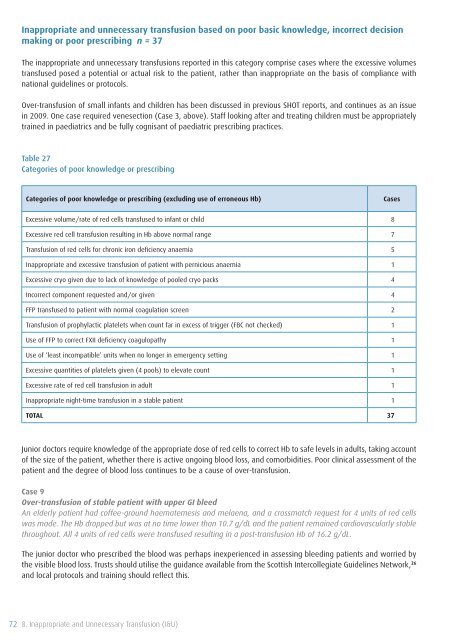SHOT Annual Report 2009 - Serious Hazards of Transfusion
SHOT Annual Report 2009 - Serious Hazards of Transfusion
SHOT Annual Report 2009 - Serious Hazards of Transfusion
You also want an ePaper? Increase the reach of your titles
YUMPU automatically turns print PDFs into web optimized ePapers that Google loves.
Inappropriate and unnecessary transfusion based on poor basic knowledge, incorrect decision<br />
making or poor prescribing n = 37<br />
The inappropriate and unnecessary transfusions reported in this category comprise cases where the excessive volumes<br />
transfused posed a potential or actual risk to the patient, rather than inappropriate on the basis <strong>of</strong> compliance with<br />
national guidelines or protocols.<br />
Over-transfusion <strong>of</strong> small infants and children has been discussed in previous <strong>SHOT</strong> reports, and continues as an issue<br />
in <strong>2009</strong>. One case required venesection (Case 3, above). Staff looking after and treating children must be appropriately<br />
trained in paediatrics and be fully cognisant <strong>of</strong> paediatric prescribing practices.<br />
Table 27<br />
Categories <strong>of</strong> poor knowledge or prescribing<br />
Categories <strong>of</strong> poor knowledge or prescribing (excluding use <strong>of</strong> erroneous Hb)<br />
Cases<br />
Excessive volume/rate <strong>of</strong> red cells transfused to infant or child 8<br />
Excessive red cell transfusion resulting in Hb above normal range 7<br />
<strong>Transfusion</strong> <strong>of</strong> red cells for chronic iron deficiency anaemia 5<br />
Inappropriate and excessive transfusion <strong>of</strong> patient with pernicious anaemia 1<br />
Excessive cryo given due to lack <strong>of</strong> knowledge <strong>of</strong> pooled cryo packs 4<br />
Incorrect component requested and/or given 4<br />
FFP transfused to patient with normal coagulation screen 2<br />
<strong>Transfusion</strong> <strong>of</strong> prophylactic platelets when count far in excess <strong>of</strong> trigger (FBC not checked) 1<br />
Use <strong>of</strong> FFP to correct FXII deficiency coagulopathy 1<br />
Use <strong>of</strong> ‘least incompatible’ units when no longer in emergency setting 1<br />
Excessive quantities <strong>of</strong> platelets given (4 pools) to elevate count 1<br />
Excessive rate <strong>of</strong> red cell transfusion in adult 1<br />
Inappropriate night-time transfusion in a stable patient 1<br />
TOTAL 37<br />
Junior doctors require knowledge <strong>of</strong> the appropriate dose <strong>of</strong> red cells to correct Hb to safe levels in adults, taking account<br />
<strong>of</strong> the size <strong>of</strong> the patient, whether there is active ongoing blood loss, and comorbidities. Poor clinical assessment <strong>of</strong> the<br />
patient and the degree <strong>of</strong> blood loss continues to be a cause <strong>of</strong> over-transfusion.<br />
Case 9<br />
Over-transfusion <strong>of</strong> stable patient with upper GI bleed<br />
An elderly patient had c<strong>of</strong>fee-ground haematemesis and melaena, and a crossmatch request for 4 units <strong>of</strong> red cells<br />
was made. The Hb dropped but was at no time lower than 10.7 g/dL and the patient remained cardiovascularly stable<br />
throughout. All 4 units <strong>of</strong> red cells were transfused resulting in a post-transfusion Hb <strong>of</strong> 16.2 g/dL.<br />
The junior doctor who prescribed the blood was perhaps inexperienced in assessing bleeding patients and worried by<br />
the visible blood loss. Trusts should utilise the guidance available from the Scottish Intercollegiate Guidelines Network, 26<br />
and local protocols and training should reflect this.<br />
72 8. Inappropriate and Unnecessary <strong>Transfusion</strong> (I&U)












